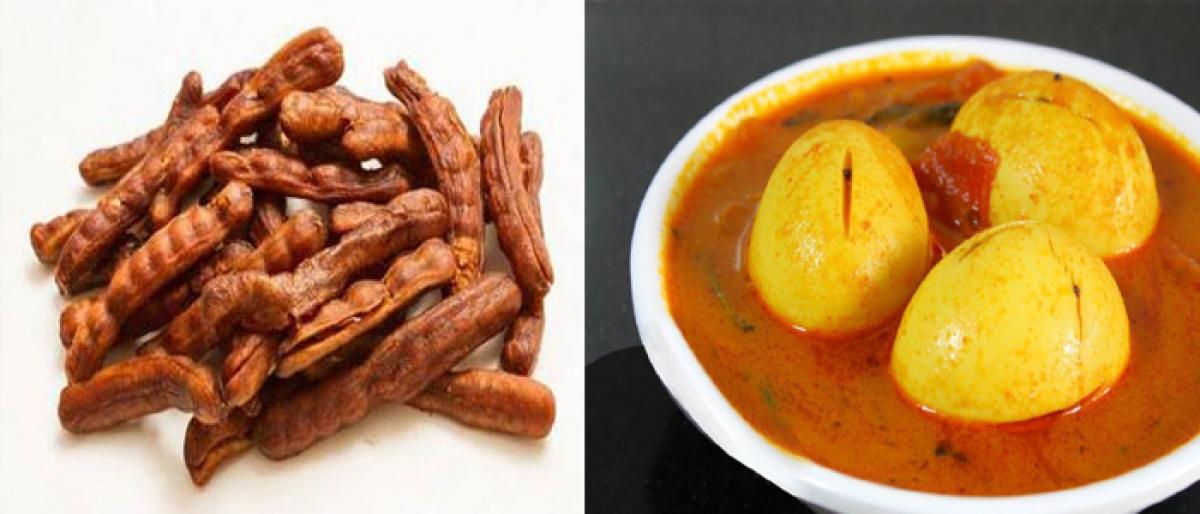Live
- BJP releases ‘charge sheet’ against BJD govt
- District Nodal Officer Venkataramana announced the intermediate results
- She team that stopped child marriages
- Medical devices sector needs separate rules, says industry body AiMeD
- Andhra Paper declares lockout
- Opposition INDIA bloc working on 'one year, one PM' formula: PM Modi
- Delhi HC quashes FIR for outraging woman's modesty, orders man to assist Traffic Police for a month as settlement
- 'Apologise to families of farmers who committed suicide in Vidarbha', Amit Shah dares Sharad Pawar
- SC Collegium recommends appointment of a permanent judge in Chhattisgarh HC, extension of term of two judges
- U20 Men's football nationals: Telangana, Sikkim earn full points with easy win
Just In

Did you know that India is the largest producer of Tamarind – Chintapandu, yet another crop that arrives in abundance during summers. In fact, it is believed in Telangana (cannot vouch for other areas) that in a year if the tamarind crop is good, then the mangoes go the other way.
Did you know that India is the largest producer of Tamarind – Chintapandu, yet another crop that arrives in abundance during summers. In fact, it is believed in Telangana (cannot vouch for other areas) that in a year if the tamarind crop is good, then the mangoes go the other way.
Coming back to the sour element in our ‘Shadruchulu’ (the six important tastes that make for the Ugadi Pachadi – the preparation that marks the beginning of the Telugu New Year - signifying the six different experiences in life), tamarind is one of the most important flavours in Indian cuisine, more so in Telugu cuisine.
While anything in excess is not good for health, people belonging to the two Telugu states can never refrain from using it. Tamarind is, in fact, known to work as coolant, especially useful in the spice-loving part of the nation, and in addition is known to be filled with nutrients, has fibre, is known to manage Diabetics, boost immunity, help in blood circulation – no wonder so much of it is used in our food.
To think that tamarind is not indigenous to Asia and comes from tropical Africa is indeed a surprising fact. However, this happened over 5,000 years ago – a good enough time has passed for it to have been sufficiently adapted into the food cycle. And even though the whole of India uses tamarind – Imli, it is we the Telugus who have mastered the art.
Hence, if we say Telugus are one of the foremost consumers of tamarind – it may not be an exaggeration. Just reflect on a typical Telugu thali with its Pappu (dal), Pachadi (chutney), Koora (curry), Rasam, Sambar – around 75 per cent and more of the dishes use tamarind in various proportions. How many times have we heard… ‘konchem pulupu thakkuvayindi – vuppu veyyi saripothundi’ – how we hate when a dish is not as sour as it is supposed to be.
And what about the ‘Pulusu’ – We make a pulusu out of every living and non-living (especially the marine ones) that’s edible – well almost! Chepala Pulusu (Fish), Royyala Pulusu (Prawns), Guddu Pulusu (Egg), Mukkala Pulusu (a combination of various vegetables), Gummadikaya Pulusu, Bendakaya Pulusu (Okra), amongst others use tamarind as its main ingredient. Juice extracted from ripe tamarind is balanced with chilli powder and a bit of sweet – be it jaggery or even sugar, and the vegetables or fish cooked in this juice gets a unique flavour that is extremely mouthwatering and signature of Telugu land.
Sometimes you wonder why a dish is known by a certain name when the main ingredient is something else. Take the amazingly delicious ‘Allam Pachchadi’ (Ginger Pickle) for instance. Well, it does have ginger but a small portion of it; which otherwise will becoming overpoweringly ginger in taste. For it to get its quintessentially balanced taste, it is endowed with a generous portion of thick tamarind juice, a little bit of jaggery and red chillies.
Yet another popular dish –one of the typical gunpowder of the region – ‘Karam Podi’ may be dry in nature, but it also uses a small portion of tamarind to tame the fieriness of it chillies.
The penchant for use of tamarind is seen even in the Muslim households of Hyderabad. Muslim kitchens conjure up a variety of sour preparations (Khatti Dal, Arvi ka Khatta, Khatta Dalcha, Kichdi Khatta) that use tamarind. In fact, the popular accompaniment to Hyderabadi Biryani, Mirchi Ka Salan is specifically made sour for connoisseurs. Even the Bagare Baingan made in Hyderabadi households use more tamarind in comparison to the northern counterparts.
The last and the most important dish in Telugu homes - Pulihara, fondly called in literal translation for a few laughs - the ‘Tiger Food’ needs mention here. Be it a festival, a celebration, a traditional bhojanam or a marriage party, at homes or in temples – Pulihara is one dish that tops the list. And when made using tamarind, this rice dish gets it utmost respect.
The rice tempered generously and mixed with boiled tamarind paste, a bit of turmeric and chillies and topped with curry leaves is a heavenly preparation; and evidently is a must in all traditional offerings during Pujas.
And can you bear the tamarind – Chintapandu Pulihara to be even a wee bit less on its tanginess…no Sir! It must be exactly right in proportion for it to be tasty, and a sleepover (when had the next day morning) gives it a better flavour.
When you see heaps of tamarind freshly picked from the trees briskly being sold in vegetable markets, one wonders if its ok to say Telugus do look forward to beginning their meals on a sour note; albeit a delicious one.

© 2024 Hyderabad Media House Limited/The Hans India. All rights reserved. Powered by hocalwire.com







